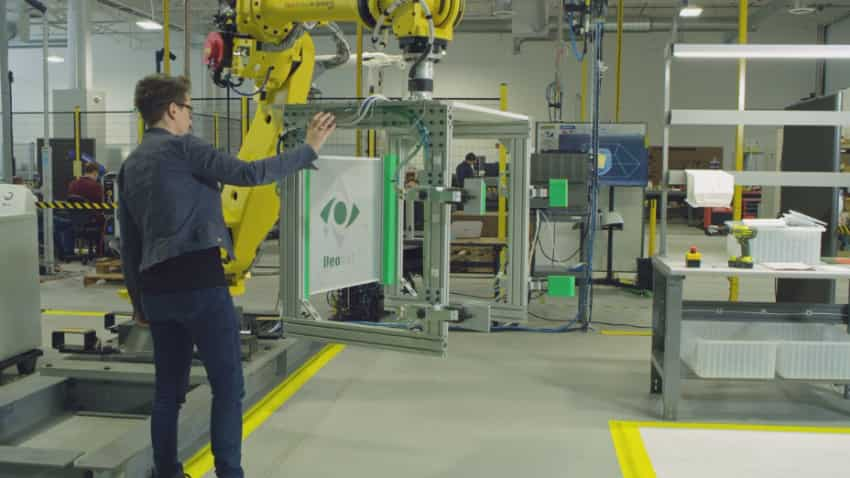Robots working hand in hand with humans? What this startup has made possible
The company transforms manufacturing with products that incorporate advanced computer vision, 3D sensing, and AI.

Robotics and Artificial Intelligence (AI) has emerged as breakthrough across globally, when it comes to getting work done in a systematic, less time-consuming and programmed manner. Many startups and companies have entered into this high-tech domain. However, where robots have become a boon to many firms, it also comes as a curse in their own ways. For instance, when it comes to specific customization in goods and services. Here is where humans come into play. But how will an environment be safe with automatic robots around? There is a startup named Veo Robotics Inc, which aims to make robots work alongside manpower safe and efficiently.
Veo Robotics is a startup based in Waltham, Massachusetts, whose main objective is to make factory robots who are safer and can work hand-in-hand with human employees in manufacturing companies. To make it possible, they have LIDAR ( Light Detection and Ranging) technology which enables robots to sense human presence when they intervene for customization and manual procedures.
Patrick Sobalvarro, co-founder and Chief Executive in an interview with Bloomberg revealed that, Veo raised $15 million last month bringing total financing to around $28 million.
“Where you see a lot of robots, that’s just the beginning of assembly. Those welding robots make for flashy pictures, but what you don’t see is another 250 to 500 process steps that are entirely manual.” Sobalvarro reportedly said.
In the latest funding round, participation was witnessed from shareholders like Google Ventures, Lux Capital Management, and Next47 -a venture firm started by Siemens AG.
Further, investors also joined Veo Robotic’s board, including Nikon-SBI Innovation Fund, SBI AI & Blockchain Fund, and Baidu Ventures.
The company transforms manufacturing with products that incorporate advanced computer vision, 3D sensing, and AI.
Alberto Moel, Vice President Strategy and Partnerships, Veo Robotics in a blog explains, manufacturing, broadly, is the process by which physical goods get transformed into other physical goods. Besides the cost of those input goods (say, the raw materials), there is the cost of the manufacturing process itself.
Moel adds that, this includes not just the actual direct labor, but also the tools and equipment required for the transformation; overheads such as supervisory labor or electricity; the parts, fixtures, and consumables required; and the engineering and design effort needed to put together, test, and upgrade the manufacturing process.
Comparing the costs required for robots and manpower, Moel states that, direct costs, such as direct labor or consumables, are estimated by figuring out labor rates and such per hour and dividing by the number of units produced per hour.
In case of robots, costs $50,000 and has a useful life of maybe 100,000 hours,2 each hour of production “costs” about 50 cents of the robot’s lifetime.
Get Latest Business News, Stock Market Updates and Videos; Check your tax outgo through Income Tax Calculator and save money through our Personal Finance coverage. Check Business Breaking News Live on Zee Business Twitter and Facebook. Subscribe on YouTube.
RECOMMENDED STORIES

Looking for short term investment ideas? Analysts suggest buying these 2 stocks for potential gain; check targets

SBI 444-day FD vs PNB 400-day FD: Here's what general and senior citizens will get in maturity on Rs 3.5 lakh and 7 lakh investments in special FDs?
07:31 PM IST










 Biotech startups in India surged from 50 to about 9,000 in last decade: Jitendra Singh
Biotech startups in India surged from 50 to about 9,000 in last decade: Jitendra Singh Startups positioning India for exponential economic growth: Zupee founder Dilsher
Startups positioning India for exponential economic growth: Zupee founder Dilsher Antler India plans to invest Rs 211 crore in 50 start-ups in 2025: Company
Antler India plans to invest Rs 211 crore in 50 start-ups in 2025: Company Cabinet clears Atal Innovation Mission 2.0 with Rs 2,750 crore outlay
Cabinet clears Atal Innovation Mission 2.0 with Rs 2,750 crore outlay Centre to unveil startups under new National Quantum Mission guidelines
Centre to unveil startups under new National Quantum Mission guidelines